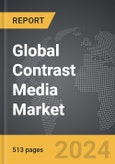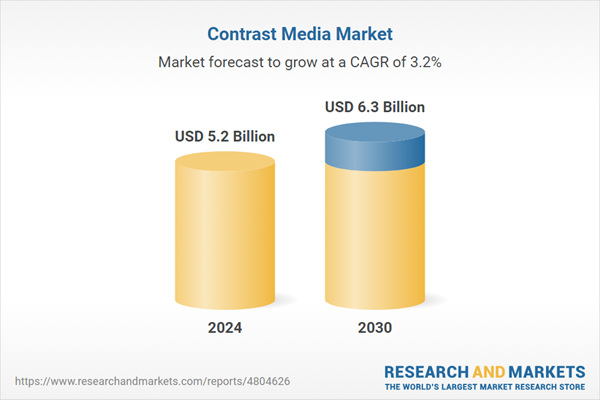The global market for Contrast Media was valued at US$5.2 Billion in 2024 and is projected to reach US$6.3 Billion by 2030, growing at a CAGR of 3.2% from 2024 to 2030. This comprehensive report provides an in-depth analysis of market trends, drivers, and forecasts, helping you make informed business decisions. The report includes the most recent global tariff developments and how they impact the Contrast Media market.
The use of contrast media has significantly evolved with advancements in imaging technology and medical protocols. Modern contrast agents are more sophisticated, with reduced toxicity and improved patient tolerance compared to earlier formulations. This advancement enhances the diagnostic accuracy and expands the scope of imaging procedures that can be safely performed. In addition to developments in the chemical properties of contrast agents, there is also an increasing focus on the development of targeted contrast media that can bind specifically to certain cells or proteins, offering the potential for not just anatomical imaging but also molecular imaging. This capability could greatly improve the early detection and treatment of diseases by allowing clinicians to visualize physiological changes at the molecular level. Furthermore, the growing adoption of hybrid imaging techniques, such as PET/CT and SPECT/CT, encourages the simultaneous use of multiple types of contrast media, opening new avenues for comprehensive diagnostics that combine anatomical and functional imaging.
The growth in the contrast media market is driven by several factors, including technological advancements in medical imaging, increasing prevalence of chronic diseases, an aging global population, and heightened awareness and demand for early and accurate disease diagnosis. As imaging technologies become more sophisticated and widespread, there is a corresponding increase in the use and development of contrast agents that are compatible with these advanced systems. The global rise in conditions such as cancer, cardiovascular diseases, and neurological disorders necessitates enhanced imaging for accurate diagnosis, staging, and monitoring, fueling demand for effective contrast media. Additionally, the aging population is more prone to chronic conditions that require ongoing medical imaging services, thereby boosting the market. Furthermore, improvements in healthcare infrastructure, especially in emerging economies, increase access to advanced diagnostic services, expanding the market reach of contrast media. Lastly, increased healthcare spending and the rising preference for minimally invasive diagnostic procedures contribute significantly to the expansion of this market, reflecting its critical role in modern medical diagnostics.
Segments: Application (Radiology, Interventional Radiology, Interventional Cardiology); Imaging Modality (X-ray/Computed Tomography (CT), Magnetic Resonance Imaging (MRI), Ultrasound); Type of Media (Barium-based Contrast Media, Iodinated Contrast Media, Gadolinium-based Contrast Media, Microbubble Contrast Media).
Geographic Regions/Countries: World; United States; Canada; Japan; China; Europe (France; Germany; Italy; United Kingdom; Spain; Russia; and Rest of Europe); Asia-Pacific (Australia; India; South Korea; and Rest of Asia-Pacific); Latin America (Argentina; Brazil; Mexico; and Rest of Latin America); Middle East (Iran; Israel; Saudi Arabia; United Arab Emirates; and Rest of Middle East); and Africa.
The analysts continuously track trade developments worldwide, drawing insights from leading global economists and over 200 industry and policy institutions, including think tanks, trade organizations, and national economic advisory bodies. This intelligence is integrated into forecasting models to provide timely, data-driven analysis of emerging risks and opportunities.
Global Contrast Media Market - Key Trends & Drivers Summarized
Contrast media, also known as contrast agents, are substances used in medical imaging to improve the visibility of internal body structures in radiographic procedures such as MRI (magnetic resonance imaging), CT (computed tomography), X-rays, and ultrasound. These agents enhance the contrast of images by altering the way imaging waves or rays are absorbed by body tissues, thereby helping to differentiate between different types of tissues or indicating the presence of disease. Common types of contrast media include iodine-based and barium-sulfate compounds for X-ray and CT scans, and gadolinium-based agents for MRI. Each type is specifically designed to target particular tissues and organs, ensuring that they provide the most effective enhancement for the imaging technique used. Safety considerations are paramount, as these agents must be carefully administered to minimize adverse reactions, with protocols in place to handle any such occurrences efficiently.The use of contrast media has significantly evolved with advancements in imaging technology and medical protocols. Modern contrast agents are more sophisticated, with reduced toxicity and improved patient tolerance compared to earlier formulations. This advancement enhances the diagnostic accuracy and expands the scope of imaging procedures that can be safely performed. In addition to developments in the chemical properties of contrast agents, there is also an increasing focus on the development of targeted contrast media that can bind specifically to certain cells or proteins, offering the potential for not just anatomical imaging but also molecular imaging. This capability could greatly improve the early detection and treatment of diseases by allowing clinicians to visualize physiological changes at the molecular level. Furthermore, the growing adoption of hybrid imaging techniques, such as PET/CT and SPECT/CT, encourages the simultaneous use of multiple types of contrast media, opening new avenues for comprehensive diagnostics that combine anatomical and functional imaging.
The growth in the contrast media market is driven by several factors, including technological advancements in medical imaging, increasing prevalence of chronic diseases, an aging global population, and heightened awareness and demand for early and accurate disease diagnosis. As imaging technologies become more sophisticated and widespread, there is a corresponding increase in the use and development of contrast agents that are compatible with these advanced systems. The global rise in conditions such as cancer, cardiovascular diseases, and neurological disorders necessitates enhanced imaging for accurate diagnosis, staging, and monitoring, fueling demand for effective contrast media. Additionally, the aging population is more prone to chronic conditions that require ongoing medical imaging services, thereby boosting the market. Furthermore, improvements in healthcare infrastructure, especially in emerging economies, increase access to advanced diagnostic services, expanding the market reach of contrast media. Lastly, increased healthcare spending and the rising preference for minimally invasive diagnostic procedures contribute significantly to the expansion of this market, reflecting its critical role in modern medical diagnostics.
Report Scope
The report analyzes the Contrast Media market, presented in terms of units. The analysis covers the key segments and geographic regions outlined below.Segments: Application (Radiology, Interventional Radiology, Interventional Cardiology); Imaging Modality (X-ray/Computed Tomography (CT), Magnetic Resonance Imaging (MRI), Ultrasound); Type of Media (Barium-based Contrast Media, Iodinated Contrast Media, Gadolinium-based Contrast Media, Microbubble Contrast Media).
Geographic Regions/Countries: World; United States; Canada; Japan; China; Europe (France; Germany; Italy; United Kingdom; Spain; Russia; and Rest of Europe); Asia-Pacific (Australia; India; South Korea; and Rest of Asia-Pacific); Latin America (Argentina; Brazil; Mexico; and Rest of Latin America); Middle East (Iran; Israel; Saudi Arabia; United Arab Emirates; and Rest of Middle East); and Africa.
Key Insights:
- Market Growth: Understand the significant growth trajectory of the Barium-based Contrast Media segment, which is expected to reach US$305.4 Million by 2030 with a CAGR of a 2.1%. The Iodinated Contrast Media segment is also set to grow at 3.3% CAGR over the analysis period.
- Regional Analysis: Gain insights into the U.S. market, valued at $2.1 Billion in 2024, and China, forecasted to grow at an impressive 4.5% CAGR to reach $408.9 Million by 2030. Discover growth trends in other key regions, including Japan, Canada, Germany, and the Asia-Pacific.
Why You Should Buy This Report:
- Detailed Market Analysis: Access a thorough analysis of the Global Contrast Media Market, covering all major geographic regions and market segments.
- Competitive Insights: Get an overview of the competitive landscape, including the market presence of major players across different geographies.
- Future Trends and Drivers: Understand the key trends and drivers shaping the future of the Global Contrast Media Market.
- Actionable Insights: Benefit from actionable insights that can help you identify new revenue opportunities and make strategic business decisions.
Key Questions Answered:
- How is the Global Contrast Media Market expected to evolve by 2030?
- What are the main drivers and restraints affecting the market?
- Which market segments will grow the most over the forecast period?
- How will market shares for different regions and segments change by 2030?
- Who are the leading players in the market, and what are their prospects?
Report Features:
- Comprehensive Market Data: Independent analysis of annual sales and market forecasts in US$ Million from 2024 to 2030.
- In-Depth Regional Analysis: Detailed insights into key markets, including the U.S., China, Japan, Canada, Europe, Asia-Pacific, Latin America, Middle East, and Africa.
- Company Profiles: Coverage of players such as GE Healthcare, Bayer AG, Ligand Pharmaceuticals, Inc., Bracco SpA, Trivitron Healthcare and more.
- Complimentary Updates: Receive free report updates for one year to keep you informed of the latest market developments.
Some of the 45 companies featured in this Contrast Media market report include:
- GE Healthcare
- Bayer AG
- Ligand Pharmaceuticals, Inc.
- Bracco SpA
- Trivitron Healthcare
- Bracco Imaging SpA
- Lantheus Medical Imaging, Inc.
- Guerbet Group
- Sanochemia Pharmazeutika AG
- Beijing BeiLu Pharmaceutical Co., Ltd.
- Fuji Pharma Co., Ltd.
- Guerbet LLC
- NanoHybrids
- Bayer AG, Pharmaceuticals
- FujiFilm VisualSonics, Inc.
Tariff Impact Analysis: Key Insights for 2025
Global tariff negotiations across 180+ countries are reshaping supply chains, costs, and competitiveness. This report reflects the latest developments as of April 2025 and incorporates forward-looking insights into the market outlook.The analysts continuously track trade developments worldwide, drawing insights from leading global economists and over 200 industry and policy institutions, including think tanks, trade organizations, and national economic advisory bodies. This intelligence is integrated into forecasting models to provide timely, data-driven analysis of emerging risks and opportunities.
What’s Included in This Edition:
- Tariff-adjusted market forecasts by region and segment
- Analysis of cost and supply chain implications by sourcing and trade exposure
- Strategic insights into geographic shifts
Buyers receive a free July 2025 update with:
- Finalized tariff impacts and new trade agreement effects
- Updated projections reflecting global sourcing and cost shifts
- Expanded country-specific coverage across the industry
Table of Contents
I. METHODOLOGYII. EXECUTIVE SUMMARYIII. MARKET ANALYSISCANADAITALYSPAINRUSSIAREST OF EUROPESOUTH KOREAREST OF ASIA-PACIFICARGENTINABRAZILMEXICOREST OF LATIN AMERICAIRANISRAELSAUDI ARABIAUNITED ARAB EMIRATESREST OF MIDDLE EASTIV. COMPETITION
1. MARKET OVERVIEW
2. FOCUS ON SELECT PLAYERS
3. MARKET TRENDS & DRIVERS
4. GLOBAL MARKET PERSPECTIVE
UNITED STATES
JAPAN
CHINA
EUROPE
FRANCE
GERMANY
UNITED KINGDOM
ASIA-PACIFIC
AUSTRALIA
INDIA
LATIN AMERICA
MIDDLE EAST
AFRICA
Companies Mentioned (Partial List)
A selection of companies mentioned in this report includes, but is not limited to:
- GE Healthcare
- Bayer AG
- Ligand Pharmaceuticals, Inc.
- Bracco SpA
- Trivitron Healthcare
- Bracco Imaging SpA
- Lantheus Medical Imaging, Inc.
- Guerbet Group
- Sanochemia Pharmazeutika AG
- Beijing BeiLu Pharmaceutical Co., Ltd.
- Fuji Pharma Co., Ltd.
- Guerbet LLC
- NanoHybrids
- Bayer AG, Pharmaceuticals
- FujiFilm VisualSonics, Inc.
Table Information
| Report Attribute | Details |
|---|---|
| No. of Pages | 513 |
| Published | April 2025 |
| Forecast Period | 2024 - 2030 |
| Estimated Market Value ( USD | $ 5.2 Billion |
| Forecasted Market Value ( USD | $ 6.3 Billion |
| Compound Annual Growth Rate | 3.2% |
| Regions Covered | Global |









